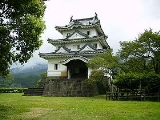
Uwajima Castle
Encyclopedia
is a hirayamashiro in Uwajima
, Ehime
, Japan
. An alternate name for this castle is Tsurushima-jo. This castle is well-known as one of the twelve Japanese castles to still have an original donjon
built in the Edo Period
.
, a Daimyō
, in 1596 after being given a small fiefdom by Toyotomi Hideyoshi
in 1595. This castle experienced major repairs and expansion by Date Munetoshi in 1671.
selected by Japanese government:
Uwajima, Ehime
is a city located in Ehime, Japan. In 1595, what is now Uwajima was known as Itajima village. Takatora Tohdo became lord of the Uwa region, and ordered the restoration of Marugushi Castle...
, Ehime
Ehime Prefecture
is a prefecture in northwestern Shikoku, Japan. The capital is Matsuyama.-History:Until the Meiji Restoration, Ehime prefecture was known as Iyo Province...
, Japan
Japan
Japan is an island nation in East Asia. Located in the Pacific Ocean, it lies to the east of the Sea of Japan, China, North Korea, South Korea and Russia, stretching from the Sea of Okhotsk in the north to the East China Sea and Taiwan in the south...
. An alternate name for this castle is Tsurushima-jo. This castle is well-known as one of the twelve Japanese castles to still have an original donjon
Keep
A keep is a type of fortified tower built within castles during the Middle Ages by European nobility. Scholars have debated the scope of the word keep, but usually consider it to refer to large towers in castles that were fortified residences, used as a refuge of last resort should the rest of the...
built in the Edo Period
Edo period
The , or , is a division of Japanese history which was ruled by the shoguns of the Tokugawa family, running from 1603 to 1868. The political entity of this period was the Tokugawa shogunate....
.
History
This castle was constructed by Tōdō TakatoraTodo Takatora
was a Japanese daimyo of the Azuchi-Momoyama period through Edo period. He rose from relatively humble origins as an ashigaru to become a daimyo...
, a Daimyō
Daimyo
is a generic term referring to the powerful territorial lords in pre-modern Japan who ruled most of the country from their vast, hereditary land holdings...
, in 1596 after being given a small fiefdom by Toyotomi Hideyoshi
Toyotomi Hideyoshi
was a daimyo warrior, general and politician of the Sengoku period. He unified the political factions of Japan. He succeeded his former liege lord, Oda Nobunaga, and brought an end to the Sengoku period. The period of his rule is often called the Momoyama period, named after Hideyoshi's castle...
in 1595. This castle experienced major repairs and expansion by Date Munetoshi in 1671.
Cultural Property
Uwajima castle has an Important Cultural PropertyImportant Cultural Properties of Japan
The term is often shortened into just are items officially already classified as Tangible Cultural Properties of Japan by the Japanese Agency for Cultural Affairs and judged to be of particular importance to the Japanese people....
selected by Japanese government:
- Tenshukaku (Donjon Tower)

